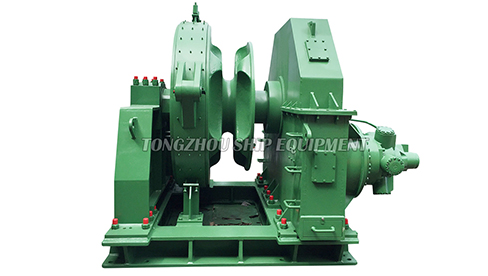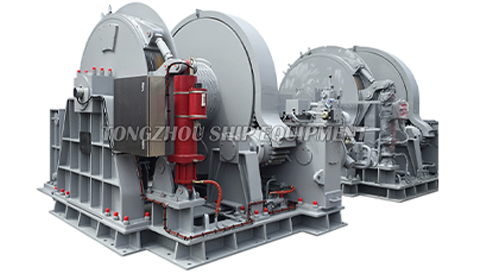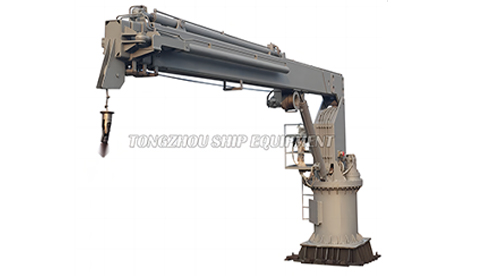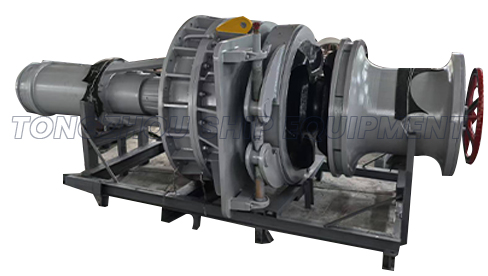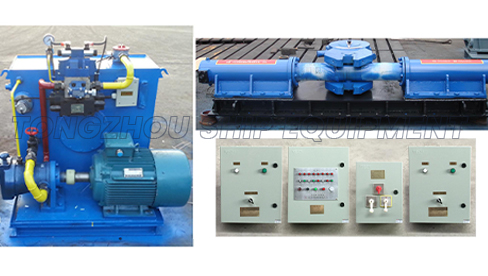Hydraulic Windlass: The Core Power of Ship Anchoring System
 2025.06.13
2025.06.13
 Industry News
Industry News
Hydraulic Windlass is one of the most important deck machinery equipment on modern ships. It is a power mechanical device specially designed for retracting and releasing anchor chains and anchors, and can reliably brake the anchor chains to bear the anchoring load. As the "heart" of the ship's anchoring system, the hydraulic windlass is driven by high-pressure hydraulic oil to provide powerful and controllable power for ships in key operations such as mooring, emergency braking, and leaving the port, ensuring the safety and maneuverability of the ship.
1. Core structure and working principle
Power source and drive unit:
Hydraulic pump station: Usually located in the ship's engine room or a special hydraulic pump room. Driven by an electric motor or diesel engine, it produces high-pressure hydraulic oil (working pressure is usually in the range of 150bar - 250bar or even higher).
Hydraulic motor: It is the core actuator of the windlass and is directly installed on the windlass body. High-pressure oil drives the hydraulic motor (usually a low-speed, high-torque radial piston motor) to rotate, providing the required huge torque. Its low-speed, high-torque, strong overload protection, and excellent speed regulation performance are very suitable for the working conditions of the anchor winch (need to overcome the weight of the anchor chain, the seabed adsorption force, and the violent impact load caused by wind and waves).
Control valve group: Located near the hydraulic motor or integrated on the anchor winch. The direction and flow of the oil flowing to the hydraulic motor are accurately controlled by the directional control valve (manual valve, solenoid valve or electro-hydraulic proportional valve), so as to achieve the forward rotation (anchoring/chain collection), reverse rotation (anchoring/chain release), stop and smooth stepless speed regulation of the anchor chain wheel. The pressure control valve (relief valve) provides system overload protection.
Core working parts - anchor chain wheel:
Structure and function: Also known as "Gypsy" or "Chain Wheel". It is a huge cast steel wheel with a special groove (chain nest). The shape and size of the chain nest must strictly match the specifications of the anchor chain used on the ship (chain ring diameter - Chain Size) to ensure that the anchor chain can be reliably engaged, wound and released to avoid chain jumping or jamming.
Dual-function design: Most modern hydraulic windlasses have a chain pulley that also functions as a cable winder. The outer side of the windlass is designed with a smooth drum (Warping Drum/Warping Head) for retracting and releasing the mooring line. The power can be switched to the chain pulley or drum through a clutch or manual operation (some designs have the chain pulley and drum driven independently).
Safety system:
Main brake (band brake/disc brake): This is the most critical safety device. When the chain pulley stops driving (whether it is completed or the operation is suspended), the main brake must be able to reliably brake and withstand the huge static load transmitted by the anchor chain for a long time (anchor grip when anchoring). It is usually a manually operated, powerful mechanical brake.
Auxiliary brake/speed regulating device: It is mainly used to control the lowering speed of the anchor chain when anchoring to prevent free fall from causing loss of control or damage to the chain pulley and anchor chain. Common forms are:
Hydraulic brake: Use the reverse resistance of the hydraulic system to form damping.
Centrifugal brake: Automatically increase the braking force as the speed of the chain pulley increases.
Water turbine brake: braking by water flow resistance (less common).
Clutch (if any): used for power connection and disconnection between the anchor chain wheel and the drive shaft, and also used to switch between the cable/chain collection functions (if shared drive).
Anchor chain stopper: Although it is usually installed on the deck near the outlet of the anchor chain pipe (Hawse Pipe), it does not belong to the anchor winch itself, but works in conjunction with the anchor winch. After the anchor is retracted, the chain stopper (Guillotine Type/Screw Type) bears the weight load of the anchor chain and anchor and fixes the anchor chain, so that the main brake of the anchor winch can be released (keeping the brake pad under pressure for a long time will cause performance degradation and wear).
2. Core advantages
Compared with electric anchor winches, hydraulic anchor winches have significant advantages:
Powerful torque and overload capacity: Hydraulic motors are naturally endowed with low-speed and high-torque characteristics, and can smoothly cope with huge sudden impact loads when lifting anchors (such as the moment when the anchor is unearthed and the impact when the ship shakes), and the system overflow valve provides reliable overload protection.
Excellent speed regulation and operability: The hydraulic valve can be used to control the speed of anchoring and anchoring steplessly, smoothly and accurately, especially when anchoring, it can achieve controllable uniform speed lowering, and the operation feel is better.
Explosion-proof and environmental adaptability: The hydraulic power source (pump station) can be arranged in a safe area (engine room) away from the deck. There are only actuators (motors, brakes) on the deck, which is inherently safe and suitable for flammable and explosive areas (tankers, chemical tankers). The hydraulic system also has good tolerance to humid and salt spray environments.
Flexible layout: High-pressure oil pipes are easier to arrange over long distances and flexibly than high-power cables, especially suitable for large ships or situations where the location of pump stations is limited.
High reliability and convenient maintenance: The hydraulic system technology is mature, the main moving parts (hydraulic motors) have a relatively simple and strong structure, and maintenance is usually carried out at the pump station (the workload on the deck is relatively reduced).
3. Main applications
Hydraulic windlasses are widely used in various types of ships that require strong and reliable anchoring capabilities:
Ocean-going merchant ships: bulk carriers, tankers, container ships, ro-ro ships, etc.
Offshore engineering vessels: pipe-laying vessels, crane vessels, drilling platform supply vessels (PSV), anchor handling tugboats (AHTS), these vessels have extremely high requirements for anchoring capabilities.
Large fishing vessels: such as ocean-going fishing vessels.
Large passenger and cruise ships.
Warships and official ships (coastal police ships, etc.).
Large yachts.
Offshore wind power installation and maintenance ships.
4. Selection and specifications
The key factors to consider when selecting a hydraulic windlass include:
Anchor chain diameter: determines the specifications of the anchor chain wheel.
Breaking load requirements: determines the strength of the machine, braking capacity and pressure level of the hydraulic system.
Anchoring speed: usually in the range of 9 meters/minute to 15 meters/minute.
Working water depth: affects the required anchor chain length and continuous working time.
Ship types and specifications: It must meet the international specifications and standards (such as SOLAS, ISO/EN standards) of classification societies (such as ABS, BV, CCS, DNV, GL, LR, NK, RINA, etc.), as well as the additional safety requirements of specific ship types (such as tankers). There are strict test requirements for braking force, overload protection capability, etc. (such as breaking load test, braking force load test).
5. Development trend
Integration and automation: Integrate with anchor chain counter and ship positioning system to achieve semi-automatic or automatic anchoring operation.
Intelligent control: Use more advanced proportional valves and sensors to achieve more accurate speed and tension control, improve operational safety and efficiency.
Energy saving and environmental protection: Optimize hydraulic system design (such as variable frequency drive pump station) and select environmentally friendly hydraulic oil (HFC) to reduce energy consumption and environmental impact.
High reliability and maintenance-free design: Use longer life seals, bearing materials and surface treatment technology.
DC networking application: On ships using DC networking power systems, hydraulic pump stations are driven by inverters for higher efficiency.
Hydraulic anchor winches are the lifeline for safe anchoring of ships. With their powerful torque output, excellent overload protection, smooth and stepless speed regulation, excellent reliability and adaptability to harsh environments, they occupy a dominant position in modern ships, especially large commercial ships, offshore vessels and special ships. With the continuous advancement of technology, hydraulic anchor winches are developing in a smarter, more efficient and more environmentally friendly direction, and continue to provide solid guarantees for the safe and efficient operation of the global shipping industry. Its core value lies in transforming invisible hydraulic energy into the majestic power to control giant anchors and chains, firmly guarding the moment of peace of ships in stormy waves.



 English
English  عربى
عربى  中文简体
中文简体 
